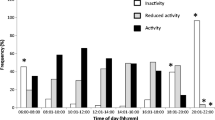Abstract
This study was aimed at making the bionomic aspects of Pseudolynchia canariensis (Macquart 1839) clear and at providing ways for keeping this diptera under laboratory conditions. A hundred and seventy-four flies were collected, of which 30% did not show hematophagy under laboratory conditions. The others were split into two groups with feeding intervals of 24 and 48 h. The individuals fed within a 24-h interval were found to live longer than the ones fed within a 48-h interval and blood meal time was decreased as feeding interval was increased. In the 48-h-feeding-interval group, females were found to live longer than the males, what could not be shown for the 24-h-feeding-interval group. Copulation was not observed in vitro, even after exposure to pigeon feathers and scraped skin. Data from this study suggest that daily feeding makes it possible to keep P. canariensis under laboratory conditions for a period of time longer than the one found for the 48-h feeding interval.
Similar content being viewed by others
Notes
Data did not show normal distribution by the Kolmogorov–Smirnov Test.
References
Arcoverde AR, Rodrigues AFSF, Daemon E (2007) A new technique for feeding Pseudolynchia canariensis (Macquart, 1839) (Diptera, Hippoboscidae) under laboratory conditions. Parasitol Res 102:135–137
Bequaert JC (1952) The hippoboscidae or louse-flies (Diptera) of mammals and birds. Part I. Structure, physiology and natural history. Entomologica Americana, New Series, New York 32:1–209
Bequaert JC (1955) The hippoboscidae or louse-flies (Diptera) of mammals and birds. Part II. Taxonomy, evolution and revision of American genera and species. Entomologica Americana 35:233–416
Bishopp FC (1929) The pigeon fly—an important pest pigeons in United States. J Econ Entomol 22:974–980
Coatney GR (1931) On the biology of the pigeon fly, Pseudolynchia maura Bigot (Diptera, Hippoboscidae). Parasitology 23:525–532
Graciolli G, Carvalho CJB (2003) Hippoboscidae (Diptera, Hippoboscoidea) no Estado do Paraná, Brasil: Chaves de identificação, hospedeiros e distribuição geográfica. Revista Brasileira de Zoologia 20(4):667–674
Klei TR, Degiusti DL (1975) Observations on bionomics of Pseudolynchia canariensis (Diptera-Hippoboscidae). Parasitology 70:195–202
Maa TC, Peterson BV (1987) Hippoboscidae, p.1271–1281. In: McAlpine JF, Peterson BV, Shewell GE, Tekey HJ, Vockeroth JR, Wood DM (eds) Manual of nearctic diptera, vol. 2. Research Branch Agriculture Canada, Ottawa, pp 1271–1281
Prouty MJ, Coatney GR (1934) Further studies on the biology of Pseudolynchia maura. Parasitology 26:249–258
Stekhoven JHS Jr, Silva II, San Román P (1954) Zur Biologie der taubenlausfliege (Diptera, Pupipara). Zeitschrift Fur Parasitenkunde 16:388–406
Stekhoven JHS Jr, Silva II, San Román P (1957) Die fortpflanzungsbiologie von Pseudolynchia canariensis (Fam. Hippoboscidea). Zeitschrift Fur Parasitenkunde 17:490–509
Author information
Authors and Affiliations
Corresponding author
Rights and permissions
About this article
Cite this article
Arcoverde, A.R., Rodrigues, A.F.S.F. & Daemon, E. Feeding and breeding aspects of Pseudolynchia canariensis (Macquart, 1839) (Diptera, Hippoboscidae) under laboratory conditions. Parasitol Res 104, 277–280 (2009). https://doi.org/10.1007/s00436-008-1188-9
Received:
Accepted:
Published:
Issue Date:
DOI: https://doi.org/10.1007/s00436-008-1188-9




